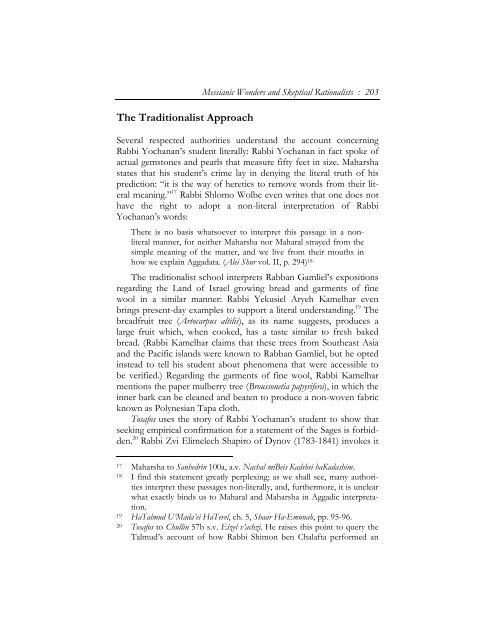Messianic Wonders and Skeptical Rationalists - Hakirah.org
Messianic Wonders and Skeptical Rationalists - Hakirah.org
Messianic Wonders and Skeptical Rationalists - Hakirah.org
You also want an ePaper? Increase the reach of your titles
YUMPU automatically turns print PDFs into web optimized ePapers that Google loves.
The Traditionalist Approach<br />
<strong>Messianic</strong> <strong>Wonders</strong> <strong>and</strong> <strong>Skeptical</strong> <strong>Rationalists</strong> : 203<br />
Several respected authorities underst<strong>and</strong> the account concerning<br />
Rabbi Yochanan’s student literally: Rabbi Yochanan in fact spoke of<br />
actual gemstones <strong>and</strong> pearls that measure fifty feet in size. Maharsha<br />
states that his student’s crime lay in denying the literal truth of his<br />
prediction: “it is the way of heretics to remove words from their literal<br />
meaning.” 17 Rabbi Shlomo Wolbe even writes that one does not<br />
have the right to adopt a non-literal interpretation of Rabbi<br />
Yochanan’s words:<br />
There is no basis whatsoever to interpret this passage in a nonliteral<br />
manner, for neither Maharsha nor Maharal strayed from the<br />
simple meaning of the matter, <strong>and</strong> we live from their mouths in<br />
how we explain Aggadata. (Alei Shur vol. II, p. 294) 18<br />
The traditionalist school interprets Rabban Gamliel’s expositions<br />
regarding the L<strong>and</strong> of Israel growing bread <strong>and</strong> garments of fine<br />
wool in a similar manner: Rabbi Yekusiel Aryeh Kamelhar even<br />
brings present-day examples to support a literal underst<strong>and</strong>ing. 19 The<br />
breadfruit tree (Artocarpus altilis), as its name suggests, produces a<br />
large fruit which, when cooked, has a taste similar to fresh baked<br />
bread. (Rabbi Kamelhar claims that these trees from Southeast Asia<br />
<strong>and</strong> the Pacific isl<strong>and</strong>s were known to Rabban Gamliel, but he opted<br />
instead to tell his student about phenomena that were accessible to<br />
be verified.) Regarding the garments of fine wool, Rabbi Kamelhar<br />
mentions the paper mulberry tree (Broussonetia papyrifera), in which the<br />
inner bark can be cleaned <strong>and</strong> beaten to produce a non-woven fabric<br />
known as Polynesian Tapa cloth.<br />
Tosafos uses the story of Rabbi Yochanan’s student to show that<br />
seeking empirical confirmation for a statement of the Sages is forbidden.<br />
20 Rabbi Zvi Elimelech Shapiro of Dynov (1783-1841) invokes it<br />
17 Maharsha to Sanhedrin 100a, a.v. Nachal miBeis Kadshei haKadashim.<br />
18 I find this statement greatly perplexing; as we shall see, many authorities<br />
interpret these passages non-literally, <strong>and</strong>, furthermore, it is unclear<br />
what exactly binds us to Maharal <strong>and</strong> Maharsha in Aggadic interpretation.<br />
19 HaTalmud U’Mada’ei HaTevel, ch. 5, Shaar Ha-Emunah, pp. 95-96.<br />
20 Tosafos to Chullin 57b s.v. Eizel v’achzi. He raises this point to query the<br />
Talmud’s account of how Rabbi Shimon ben Chalafta performed an
















